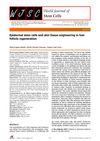Deriving Keratinocyte Progenitor Cells and Keratinocytes from Human-Induced Pluripotent Stem Cells
August 2020
in “
Current protocols in stem cell biology
”
human-induced pluripotent stem cells keratinocyte progenitor cells keratinocytes all-trans retinoic acid L-ascorbic acid bone morphogenic protein-4 epidermal growth factor hair follicle bulge stem cells CD200 ITGA6 ITGB1 P63 KRT15 KRT19 KRT14 hair follicle restoration hiPSCs KPCs ATRA L-AA BMP4 EGF HFBSCs
TLDR Scientists developed a way to create skin and hair cells from human stem cells, which could help treat burns and restore hair.
In the study from August 3, 2020, researchers developed a protocol to differentiate human-induced pluripotent stem cells (hiPSCs) into keratinocyte progenitor cells (KPCs) and mature keratinocytes, which are essential for hair and skin regeneration. This differentiation was achieved using a combination of all-trans retinoic acid (ATRA), L-ascorbic acid (L-AA), bone morphogenic protein-4 (BMP4), and epidermal growth factor (EGF). The hiPSC-derived KPCs were found to express markers consistent with primary hair follicle bulge stem cells (HFBSCs), such as CD200, ITGA6, ITGB1, P63, KRT15, and KRT19. Upon further differentiation, these cells lost CD200 expression and gained KRT14 expression, indicating their maturation into keratinocytes. These findings suggest that hiPSC-derived KPCs and keratinocytes could potentially be used for hair follicle restoration and the treatment of large burns or ulcers, respectively. The study also included various protocols for reprogramming skin fibroblasts into hiPSCs, differentiating hiPSCs into KPCs and keratinocytes, and supporting procedures such as cell passage and immunostaining techniques.

